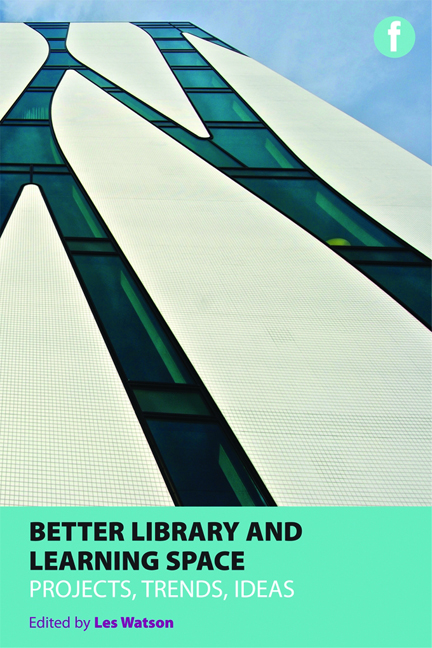Book contents
- Frontmatter
- Contents
- Case studies
- Acknowledgements
- Contributors
- Introduction – about this book
- PART 1 PROJECTS AND TRENDS
- PART 2 TRENDS AND IDEAS
- Introduction
- 7 Library space and technology
- 8 Library space and learning
- 9 Key ideas on space
- 10 Thinking it through
- Summary to Part 2
- PART 3 IDEAS AND FUTURES
- Index
10 - Thinking it through
from PART 2 - TRENDS AND IDEAS
Published online by Cambridge University Press: 08 June 2018
- Frontmatter
- Contents
- Case studies
- Acknowledgements
- Contributors
- Introduction – about this book
- PART 1 PROJECTS AND TRENDS
- PART 2 TRENDS AND IDEAS
- Introduction
- 7 Library space and technology
- 8 Library space and learning
- 9 Key ideas on space
- 10 Thinking it through
- Summary to Part 2
- PART 3 IDEAS AND FUTURES
- Index
Summary
Introduction
The tension between the certainty that is required by project delivery and the imagination that is needed to conceive and vision a project is mentioned in several places in this book (for example in the introduction and Chapter 21). There can be no argument that on-time and on-budget delivery is not just a highly desirable outcome of any project; it is essential, but it should also be recognized that imaginative solutions that make the project fit for the present and future are at least equally important. In a chapter titled ‘How little we know’ in his book The Halo Effect Phil Rosenzweig (2008) quotes social psychologist Eliot Aronson who observed that ‘people are not rational beings so much as rationalizing beings. We want explanations. We want the world around us to make sense.’ Creating that ‘sense’ certainly means building on what we know, but to create something new and amazing can only be achieved by taking a ‘both and’ approach, which combines the best of what we know, from our professional expertise and experience and research, with the best of what we can create by imagination.
Chapters 8 and 9 touch on the importance of creativity, experiences and emotions in respect of space. In this chapter I continue these themes by discussing some common ways of thinking about projects, and emphasizing tools and techniques for planning creatively. Thinking outside the box is something of a cliché but it is required at the outset of a project from all concerned. De Bono (2000) argues that we should be concerned with ‘skills as a thinker’ if we are to create the future – and one of the most important, and often neglected, aspects of our thinking skills is intuition. Albert Einstein once said, ‘The intuitive mind is a sacred gift and the rational mind is a faithful servant. We have created a society that honours the servant and has forgotten the gift’ (quoted in Staes, 2008).
The idea of ‘both and’ means that we need to strike a balance between the rational and the intuitive minds. Currently this balance is strongly tilted towards the rational mind in most organizations and building projects. Shifting the emphasis to the intuitive mind opens up thinking, making it more likely that a project will have the elusive ‘wow’ factor.
- Type
- Chapter
- Information
- Better Library and Learning SpaceProjects, trends and ideas, pp. 131 - 144Publisher: FacetPrint publication year: 2013



